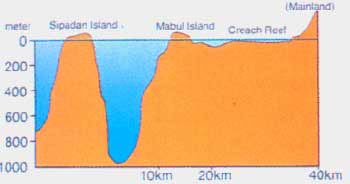Malaysia Diving
Malaysia Dive Regions
- Peninsular Malaysia
- Malaysian Borneo
Malaysia Diving
Malaysian Borneo
The East Malaysian state of Sabah, right on the northern tip of Borneo, is blessed with some of the world's very best dive spots -- most famously the atoll island of Sipadan in the Celebes Sea and the atoll reef of Layang Layang, also known as the Swallow Reef, far out in the South China Sea.
But there are other dive locations worthy of note too, depending on the kind of diving you are looking for, and offering exceptional possibilities to combine different types of diving experiences.
Labuan
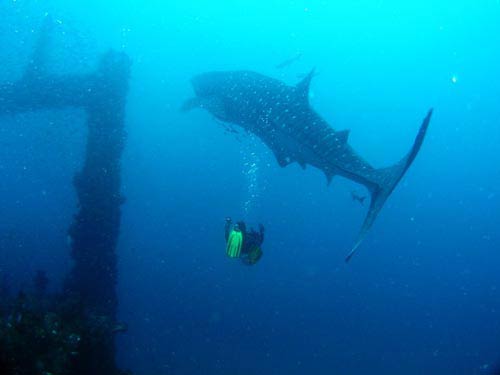
Famous for its four well-preserved, easily accessable ship wrecks, inlcuding The Australian Wreck, The American ...

Famous for its four well-preserved, easily accessable ship wrecks, inlcuding The Australian Wreck, The American Wreck and The Blue Water Wreck, which gets its name from the clear blue waters in which the wreck lies, Labuan is a tiny island on the west side of Sabah, the northernmost Malaysian state on the island of Borneo.
Labuan Wreck Diving
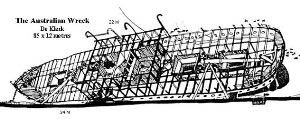 The Australian Wreck
The Australian Wreck
Name: SS De Klerk
Type: Cargo/Passenger Steamer
Dimensions: L85 m, B12 m, DR6 m (approx)
Year Built: 1900
Built By: Unknown
This wreck lies south west of Rusukan Besar Island about 23km from Labuan and is anything but Australian. It is the wreck of a cargo and passenger steamer originally named SS De Klerk, built in Amsterdam in 1900 and pying what was then the Dutch West Indies. During World War II the Dutch scuttled the ship to prevent it from falling into Japanese hands. But the Japanese salvaged the ship and renamed it the "Imbari Maru". In 1944 while on a voyage to Manila it struck a mine off Lauban and sank. Three hundred thirty nine (339) passengers lost their lives, mostly workers and prisoners of war. The wreck lies on the sea bed under 21 meters of water. Experienced divers will enjoy exploring the interior of the wreck. Others will appreciate the variety of marine life around it, including soft corals, lion fish and seldom seen frog fish. It is a good subject for underwater photography.
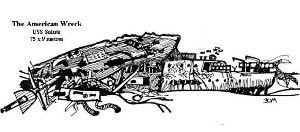 The American Wreck
The American Wreck
Name: USS Salute
Type: US Navy Minesweeper
Dimensions: L184 ft, B33 ft, DR9 ft
Year Built: 1943
Built By: Winslow Marine Railway and Shipbuilding Co., Seattle, Washington DC, USA
This wreck lies south-west of Rusukan Kecil Island, 1.4 km away from the Australian wreck and about 24 km from Labuan. It is the "USS SALUTE", a US Navy minesweeper built in Seattle, Washington in 1943. It was first put into service in Hawaii in 1944 escorting convoys between Pearl Harbour and several ports in the Far East. Later it was involved in intense action, providing protection for anti-aircraft vessels and submarine, as well as minesweeping. After several minesweeping operations in Philippines, the ship began operating in Brunei Bay where it struck a mine in 1945. Nine US sailors lost their lives when she sank.
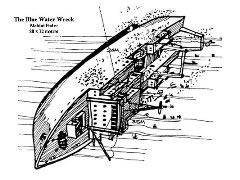 The Blue Water Wreck
The Blue Water Wreck
Name: Mabini Padre
Type: Stren Trawler
Dimensions: L80 m, B12 m, DR6 m
Year Built: Unknown
Built By: Unknown
This wreck lies northeast of Kuraman Island and is 34 km from Labuan. It gets its name from the clear "blue" waters in which it lies. Of all the wrecks, this one has the best visibility. The wreck is the "MABINI PADRE", a large Philippines fishing trawler which caught fire and sank on 13 November 1981. She is approximately 265 ft (80 m) long and lies on her port side on a hard sand bottom in 115 ft (35 m) of water. It is an interesting site for divers as it is completely intact. It also supports a wealth of marine life like soft corals, grouper and bat fish.
The Cement Wreck
Name: MV Tung Hwang
Type: Freighter
Dimensions: L92 m, W15 m, DR7 m
Year Built: Unknown
Built By: Unknown
The 'Tung Hwang' is a freighter that sank while transportating cement to Brunei for the Sultan's new palace. It hit the Samarang Bank and sank as it tried to reach Labuan for repairs. Fortunately, no lives were lost. The wreck now lies east of Kuraman Island and just 21 km from Labuan. It has settled in an upright position. It is the easiest wreck to navigate making it ideal for training in wreck diving. Divers can swim around in the cargo hold and docks. There is a great variety of marine life to be found here including barracuda, turtles, lion fish and reef fish. Soft and hard corals grow on the surface of the wreck, which makes this the best Labuan wreck for underwater photography.
Pulau Lankayan
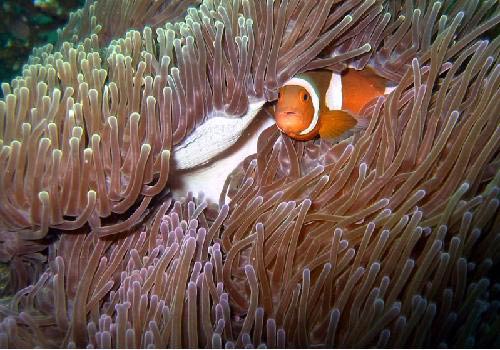
This isolated tropical island, one and a half hours by boat north of Sandakan, is ...

This isolated tropical island, one and a half hours by boat north of Sandakan, is Malaysia's only dive resort in the Sulu Sea.
As well as long stretches of white sandy beach, swaying casuarinas pines and beautiful sunrises and sunsets, Lankayan is a macroworld paradise. Saved are large stretches of beautiful hard and soft corals belonging to numerous genera, which are home to a multitude of macroworld subjects and juvenile fishes.
Pelagics also abound from large schools of scads, yellow tail barracudas, jacks, and more. There are schools of medium to large bumphead parrotfish, large rays, guitarfish and even manatees.
For those more inclined towards the smaller denizens of the reefs, there are numerous juvenile fish, claw anemone fish, decorator and spider crabs, coral shrimps, nudibranchs, prawn gobies and such rarer subjects as seahorses, ornate ghost pipefish and flying gunards.
There are large stretches of unspoiled lettuce and staghorn along with other hard corals, while the many varieties of soft coral include feather stars, sponges and sea fans. Plenty of anemones and their partners, the clown anemone fish, shrimp and porcelain crabs are also evident.
Whale Shark Season
Whale sharks returned to Lankayan again in April. Sightings of one or more individuals at a time were registered on an almost daily basis. Huge whale sharks are usually sighted by the resort's boatmen in the early morning and alerted by radio -- the dive boats speed right away to meet the peaceful, enormous creatures busy feeding on plankton and skipjacks. The location of a whale sharks is usually indicated by flocks of seabirds diving and screeching above the surface, whereupon divers can cautiously approach.
While not guaranteed, there is a high probability of encountering whale sharks from Lankayan during the months of March, April and possibly May.
Layang Layang
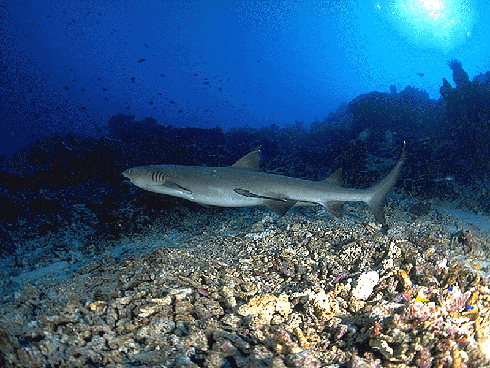
Translated from Malay, Layang Layang means "Swallows Reef". The island is located in waters 2,000 ...

Translated from Malay, Layang Layang means "Swallows Reef". The island is located in waters 2,000 metres deep, Layang Layang is an atoll of 13 linked coral reefs. The island is part of the 600 islands, reefs and shoals in the South China Sea known as The Spratlys.
Layang Layang is an atoll in the South China Sea some 300 km north-west of Kota Kinabalu. The island is man-made and was constructed for the Malaysian Navy and later developed for the only dive resort, the Layang-Layang Island Resort. The island location offers absolute isolation, and the only mode of getting there, except by boat, is the regular Malaysia Airlines flights from Kota Kinabalu. The extreme location of Layang-Layang, the pristine reefs, excellent visibility, steep walls down to 2,000m and regular sightings of pelagics have given Layang-Layang the much deserved reputation of being one of the top 10 dive locations in the world. With resident schools of barracuda and big-eye trevally, and frequently sightings of green and hawksbill turtles, the reef has something to offer for everyone. The corals are plentiful and healthy with sea fans more than three meters across, filtering plankton from passing currents. The 20m deep lagoon has some great macro creatures to be found, including seahorses, cuttlefish and pipefish but it is the pelagics visiting the outer walls that truly excite divers. Schools of scalloped hammer sharks, grey reef sharks, leopard sharks and the occasional threshers and silvertip sharks can all be seen.
Mantanani
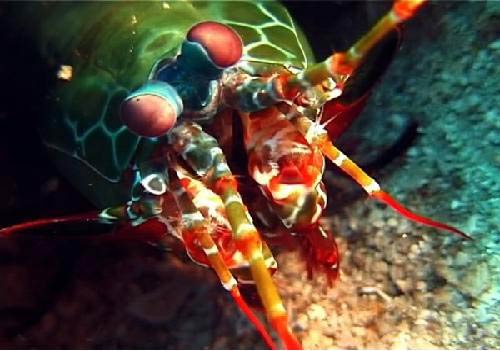
Mantanani is a group of 3 isolated islands northwest of Kota Belud, or about an hour's ...

Mantanani is a group of 3 isolated islands northwest of Kota Belud, or about an hour's drive from the state capital of Kota Kinabalu. Although only approximately an hour's boat ride by speedboat from the mainland, the islands are a reminder of an earlier and simpler place and time. Time slows down here amidst the crystal clear blue waters lapping on white sandy beaches.
Mantanani Resort lies at the edge of a white sandy bay at the western end of the largest island. Nestled amidst the tall coconut palms, are scattered beach cabins surrounding the main plantation styled house. These large and comfortable cabins come with attached bathrooms and air conditioning. The relaxing atmosphere makes this resort one of the best places to come to relax and get away (even for a little while) from the drumbeat of urban life. Afterall, there's only one resort here in these 3 islands, not the other way around.
The Mantanani resort is a pleasantly modest affair, with a collection of clean and basic air conditioned en suite bungalows grouped around a central dining area. The location is difficult to fault - It’s literally a five second walk into the sea from your front door. The dive store is about 10 seconds walk away. There are plans currently afoot for Mantanani’s resort to get a makeover with some additional landscaping and a seafront bar, designed to help the buildings blend further into the surrounding jungle and to add some more touches of luxury.
We only did one dive here and I wish it had been more - the viz was spectacular, at least 25 metres and the water was transparent - just sinking down to the reef in such perfect conditions was an experience, seeing the different hues of blue lit up by the sun above us. Our leisurely tour along the Naoko Paradise reef revealed an abundance of fish life, including sting rays, numerous different species of puffa fish and, my own personal favourite, a cuttlefish, who seemed quite content to let us hover nearby and watch him cycle through his kaliedoscopic collection of colours. With the conditions so calm and visibility so good, Mantanani seems a great destination for underwater photographers to get some worthwhile snaps without having to be an aquatic David Bailey.
Sipadan, Mabul And Kapalai
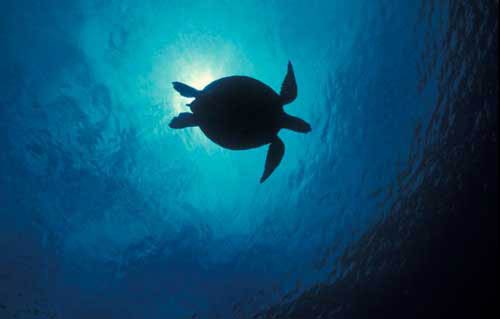
Already legendary as one of the world's best dive sites always making the top ...

Already legendary as one of the world's best dive sites -- always making the top ten of any list -- is the tiny island of Sipadan, just off the east coast of the Malaysia state of Sabah on the island of Borneo.
Popular TV naturalists Jacques Cousteau and David Attenborough have devoted whole programs to this tiny atoll, deservedly so. On a single dive you will see turtles, reef sharks, swirling barracuda, jacks, hard and soft corals and countless smaller fish. Passing pelagics are also almost a daily sight; in one dive we saw whaleshark, mantas and hammerheads.
Perhaps one of the most extraordinary features of Sipadan, however, is the sheer drop-off right in front of the house beach, plunging to 700m (more than 2000ft). Each evening, your night dive will be a short stroll from the dive centre into pristine tropical waters to put your BCD on in the shallows, then a quick confab with your dive buddy -- will it be left or will it be right tonight -- before stepping off the ledge. You will see turtles sharing hollows in the wall with giant bumphead parrotfish, fast asleep, while hundreds of colourful night critters make their way into your torch beam.
Since 2005, to protect reef and marine life, all the resorts on the island have been closed down and it is now necessary to stay at one of the nearby islands of Mabul or Kapalai, or stay on the mainland. The number of divers visiting each day is also restricted and a quota system is in place, shared between all the dive operations in the area.
Mabul
The world may well be familiar with the famous wall diving and huge schools of fish & pelagics at Sipadan, but just 15 minutes away lies its lesser known neighbour, Mabul Island. Here exists a collection of some of the most rare and unique marine creatures to be found anywhere on earth. Diving at Mabul will present you with underwater treasures, many indigenous to the Indo Pacific. Ghost pipefish, frogfish, numerous species of colorful nudibranch, gobies, shrimps, Mandarin fish, crocodile fish, sea moths and the elusive paintpot cuttlefish ( as seen in the photo below - only 12cm long ) to name just a few.
Kapalai
This unique dive resort is built on a sand bar only 15 minutes from its more famous neighbour, Sipadan Island. The sand bar was many years ago the island of Kapalai, but erosion has taken its toll on what was once a truly beautiful island. The village sits on what is known as the Ligitan Reefs, a very extensive stretch bordering the deep and vast Sulawesi Sea.
The underwater scene is completely different from Sipadan's. It is a macroworld of significant interest featuring rare subjects ranging from dragonets, fire gobies, partner and sleeper gobies, wasp or leaf fish, gurnards, the strange "little dragonfish" or seamoth, the tame crocodile fish, giant frogfish of different colors, eels, rays, just to name a few.
The resort is constructed on stilts over the water and guests can observe the antics of squids or the never-ending raids of the needlefish and halfbeaks into shoals of silversides and anchovies from their balcony.
April through October is the best time to visit. The rainy season is November to March. The water temperature ranges from 26 to 30ºC (79 to 86F) year round.
With the eviction of all dive centres on Sipadan Island itself at the end of 2004, Mabul and Kapalai have become the most in-demand places to stay for those wishing to dive the awesome Sipadan drop off, Shark & Baracuda Points etc. To protect the island, a strict limit on the numbers of divers allowed to Sipadan in any one day is being enforced, with each resort being allotted a quota.
Tunku Abdul Rahman National Park
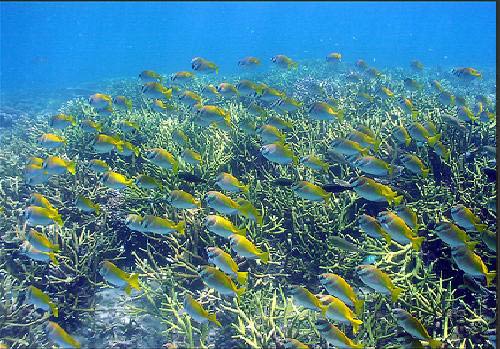
Named after Malaysia's first Prime Minister, Tunku Abdul Rahman, the five islands ...

Named after Malaysia's first Prime Minister, Tunku Abdul Rahman, the five islands of the Tunku Abdul Rahman Park (TAR) and their surrounding seas have long been a haven of peace and tranquility. The islands protect the natural vegetation, animals and the underwater gardens of the coral reefs that provide visitors with endless hours of enjoyment. TAR encompasses five islands: Gaya, Sapi, Manukan, Mamutik and Sulug. The marine national park is only 20 minutes by boat from Kota Kinabalu, (refer to A2 on our KK city map), Sabah's Capital and Malaysia's youngest city. The TAR Park is a major landmark of the city of Kota Kinabalu and is famous for the its crystal clear waters and beautiful corals, just a stones throw away from the capital. The park is very popular for activities such as sun bathing, BBQ, diving, fishing, snorkelling, kayaking, windsurfing and recently parasailing, which offers visitors a great bird's eye view of the city and the islands with Mt. Kinabalu as the back drop!
Marine Life
Reefs fringe all the islands, especially on the sheltered eastern and southern sides where the sandy beaches slope gradually into the water to the reef drop-off. In contrast, the western and northern beaches pounded by the swell from the open sea and the monsoon winds are more exposed, with rocky cliffs and banks of coral rubble.
The fish are almost as numerous and even more colourful than the corals, spotted, striped and patterned in a variety of rainbow colours. Pink-and-green Parrot fish, the Turquoise Moon Wrasse and Butterfly fish in all combinations of colours are available. Clown fish, sea cucumbers and star fish are common. If you are very lucky you might encounter a school of Trevally, or the ever friendly Whale Shark! TAR Park is a great place to begin your diving experience as a training ground before moving on to some of Sabah's world-class dive spots such as Layang Layang or Sipadan.
Miri
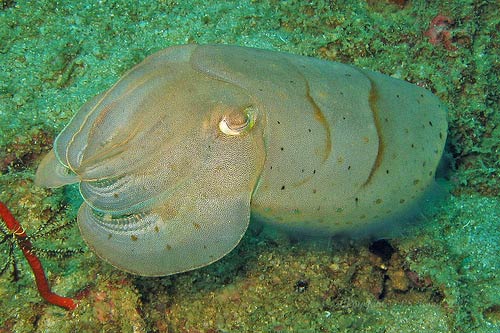
Borneo offers some of the most fantastic opportunities for divers. These include coral reefs, WWII shipwrecks, ...

Borneo offers some of the most fantastic opportunities for divers. These include coral reefs, WWII shipwrecks, drop-off, unspoiled shallow reefs with a huge diversity of pelagics and corals. From the beginner level to the experience divers, Miri reefs offer all levels of diving.
North & South Luconia shoals
Located approximately 120 nautical miles NNE from Miri, Sarawak. These reefs form a chain, bordering a few hundred square miles. Sightings of giant Manta Ray are common. Fantastic wall dives. Drop-off to 1000 ft and beyond. Breathtaking visibility (over 100ft). This swallow reef of just 20 - 30 ft is carpeted with soft corals such as leather corals, elephant's ear and dead man fingers. Giant anemones and clown fishes are all over the reef. This reef is also characterized by the schooling yellow tail fusiliers and angels. During August there are the migrating green turtles finding refuge in the crevices here.
Mike's Reef
Name after the founder is one of the most interesting reefs with a depth range of 35 - 40 ft. Both hard and soft corals thrive here. You wouldn't miss the bubble corals, anchor corals and the colorful dendronepthya. Others like feather stars, giant clams, nudibranchs and schooling yellow tail are plentiful.
Sea Fan Garden
A unique reef of 50-60 feet in depth that provides an excellent environment for an amazing variety of gorgonian sea fans and sea whips. The schooling batfish always curiously watching the divers.
Sunday Reef
A perfect way to spend a Sunday! Large varieties of hard corals make up this 35 - 45 ft reef. Photographers never run out of subjects on this rich inhabited reef. A reef to be enjoyed by divers of all age and levels of interest.VHK Reef It is exhilarating to swim among the schooling grunts which dominate over a large area of plate corals at 35 - 45 ft. Anemones, feather stars in variety, sponges, parrot fish, yellow tail fusiliers, butterfly fish and angel fish are some of those that will accompany you throughout the dive.
Grouper Patch
Giant groupers inhabit this reef of 55 - 65 ft. Spiny Lobsters are also another prominent inhabitant together with yellow tails.and schooling mackerels. Basically a rocky outcrop, more hard corals than soft ones. Fun to dive for those who has never seen a mega size Grouper!
Tyre Reef
Sitting on the white sandy bottom at 45 feet is a 200 meters x 5-10 meters stretch of giant tyre stings together to form an artificial reef constructed by the Malaysian Fisheries Department. It has attracted a myriad of marine life. From A-Z.
Scubasa Drop Off
The furthest reef from shore. approximately 24-28 Km. Steep wall 66 feet - 145 feet drop with varieties of large to medium marine life. Quite often it offers good visibilty. Marine life seen here : sharks, giant grouper, humphead wrasse, trumpet fish, turtles, whale sharks ( certain season), unicorn fish, stingrays.
'Atago Maru' shipwreck
A Second World War Japanese wreck off Lutong. The 356 footer Merchant converted to Troop transport ship is sitting upright with the top deck just 30ft ( 10meters ) from the surface. Most of the hull is covered with cave corals. A 60Kg giant grouper has made its home here. Large travellies, barracudas, African pompanos are resident fish here.
Sandakan
Sandakan is the jump off poiunt for Lankayan island, located an hour by boat into the Sulu Sea.
Sandakan is the jump off poiunt for Lankayan island, located an hour by boat into the Sulu Sea.


